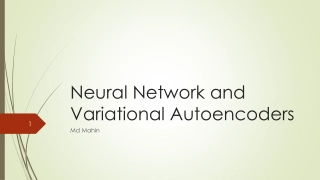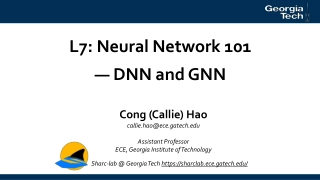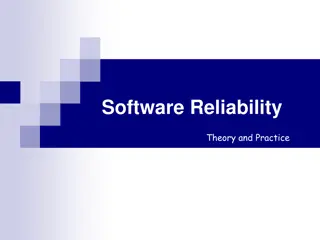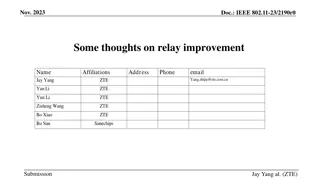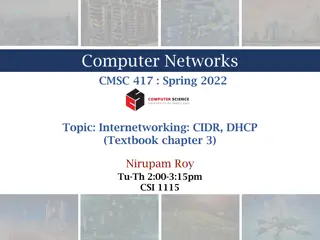Ensuring Reliability of Deep Neural Network Architectures
This study focuses on assuring the reliability of deep neural network architectures against numerical defects, highlighting the importance of addressing issues that lead to unreliable outputs such as NaN or inf. The research emphasizes the widespread and disastrous consequences of numerical defects in high availability scenarios, detailing common problems and proposing solutions to enhance the robustness of DNN models.
Download Presentation
Please find below an Image/Link to download the presentation.
The content on the website is provided AS IS for your information and personal use only. It may not be sold, licensed, or shared on other websites without obtaining consent from the author. Download presentation by click this link. If you encounter any issues during the download, it is possible that the publisher has removed the file from their server.
Presentation Transcript
Reliability Assurance for Deep Neural Network Architectures Against Numerical Defects Luyao Ren Peking University Yingfei Xiong Peking University Yuhao Zhang University of Wisconsin-Madison Linyi Li University of Illinois Urbana-Champaign Tao Xie Peking University
Background DNN Architectures Defined by Python Programs Define DNN architecture with Python libraries (e.g., PyTorch, Tensorflow) 1 2 3 4 5 6 7 8 9 input_data = tf.placeholder("float", [32, 784], name='x-input') input_labels = tf.placeholder("float", [32, 10], name='y-input ) self.W_ = tf.Variable(tf.zeros([n_features, n_classes]), name='weights') self.b_ = tf.Variable(tf.zeros([n_classes]), name='biases') model_output = tf.nn.softmax(tf.matmul(self.input_data, self.W_) + self.b_) cost = -tf.reduce_mean(ref_input * tf.log(model_output) + (1 - ref_input) * tf.log(1 - model_output), name='cost') self.obj_function = tf.reduce_min(tf.abs(model_output), name='obj_function') Initialize weights from random DNN model = architecture + weights weights = random_init() model = architecture( , weights) 10 11 12 13 Training phase: Feed in training dataset to update weights weights = architecture(training_data, weights) DL program defines DNN architecture Inference phase: Feed in test data instance to get prediction result = architecture(test_data, weights) 2
Numerical Defects Define DNN architecture with Python libraries (e.g., PyTorch, Tensorflow) result = architecture(test_data, weights) print(result) >> inf / nan Initialize weights from random DNN model = architecture + weights weights = random_init() model = architecture( , weights) When numerical defect triggered, DNN model outputs inf or nan rather than meaningful numbers Training phase: Feed in training dataset to update weights weights = architecture(training_data, weights) Inference phase: Feed in test data instance to get prediction result = architecture(test_data, weights) 3
Numerical Defects are Widespread & Disastrous Serious consequence: Output inf or nan, result in system crashes Disastrous in high availability scenarios Example: DL for threat monitoring, DL for system controlling Wastes massive time and resource to fix Widely exist: One of most common issues in DL programs [1,2] At architecture level All models sharing same architecture inherit the defects Affect lots of developers & users Hours, Days, Weeks, Months, [1] An empirical study on tensorflow program bugs. ISSTA 2018 [2] DeepStability: A study of unstable numerical methods and their solutions in deep learning. ICSE 2022 4
We propose RANUM First Holistic Framework for Assuring Numerical Reliability Key Technique Solved Open Problems Input: DNN Architecture Solve: How to support generic architectures, including dynamic ones? Static Analysis with adaptive block merging Potential-Defect Detection Locate Nodes with Numerical Defects Solve: How to generate training data to confirm feasibility? Feasibility Confirmation Step a: Generate Failure-Exhibiting Unit Tests DLG Attack Step b: Generate Failure-Exhibiting System Tests Solve: How to fix or bypass numerical defects automatically? Abstraction Optimization with differentiable abstraction Fix Suggestion Suggest to Add Clipping Operators 5
Running Example (DNN architectures are auto-convertible to acyclic computational graphs)
Task: Detection of Potential Defects Numerical defect triggered when vulnerable operator receives invalid input E.g., negative input for Log operator For all operators, detect whether its input can be invalid 7
Approach Static Analysis based on Inteval Bound Propagation Key idea: Propagating intervals of possible values through nodes Starting from interval of input & weight nodes [ 10,10 , 10,10 ] 10,10 10,10 10,10 10,10 x-input 1 weights 3 MatMul 2 [ 200,200 , 200,200 ] [ 10,10 , 10,10 ] 4 5 Add Induce input interval of each operator [ 210,210 , 210,210 ] biases 6 Softmax Const=1 [ 0,1 , 0,1 ] 7 8 Sub 17 Abs 10 Log ! [ 0,1 , 0,1 ] If interval overlaps invalid range, alert [ 0,1 , 0,1 ] 9 Log ! 8
Too Costly! Modern DNN is large some data are large tensors E.g., ImageNet model input size = 3 224 224 1.5 105 Outcome: Per-element interval abstraction is too costly Complexity (# operators avg # operands avg # tensor size) Large A few times slower than model inference 9
Optimization of Static Analysis Observation: For large tensors, usually the same valid input interval across different elements Solution: Merge blocks in a tensor (adaptively and selectively) (2,8) (4,5) (3,8) (4,6) (3,9) (1,9) (1,9) (2,9) (3,9) (3,9) 4 Blocks (3,7) (3,6) (4,7) (4,8) (1,9) (3,9) (4,8) (5,8) (1,9) (2,9) Interval Bound (??,??) for 4 4 Tensor 10
Task: Fix Suggestion via Input Clipping Observation: developers fix numerical defects by clipping Log(x) Log(clip(x, min=1e-6)) 1 x-input weights Regularize input Clip input nodes (e.g., ) 1 3 MatMul 2 Users: 4 5 Add 11 biases 6 Softmax Const=1 Regularize weights Clip weight nodes (e.g., ) 2 Model Trainers: 7 y-input 8 Sub ! 17 Abs ! 10 Log 11 9 Log 4 12Const=1 18 ReduceMin 15 Mul obj_function 14 Mul 13 Sub Change architecture Clip internal nodes (e.g., 3 MatMul Architecture Designers: 16 Add cost 19 ReduceMin ) 6 Softmax 8 Sub 5 Add 11
Problem Formulation Clip input nodes (e.g., ) Clip weight nodes (e.g., ) Clip internal nodes (e.g., ) 6 Softmax Given generate clipping threshold such that : nodes to clip, 1 11 for all nodes 4 2 3 MatMul 5 Add 8 Sub As long as inputs for specified nodes are clipped, vulnerable operators always receive valid input 12
Example - A Successful Fix: Clip on weight node 2 [ 10,10 , 10,10 ] 10,10 10,10 2,2 10,10 10,10 2,2 2,2 2,2 x-input 1 Fix @ here weights 3 MatMul 2 [ 200,200 , 200,200 ] [ 20,20 , 20,20 ] [ 10,10 , 10,10 ] 4 5 Add [ 210,210 , 210,210 ] [ 30,30 , 30,30 ] 8.8 10 27,1 8.8 10 27, (8.8 10 27,1 8.8 10 27)] ) 10 27, (8.8 10 27,1 8.8 10 27)] biases [( 6 Softmax ) Const=1 [ 0,1 , 0,1 ] 8.8 10 27,1 8.8 7 [( 10 27, 8.8 10 27,1 8.8 8 Sub [( ) 17 Abs 10 Log ! [ 0,1 , 0,1 ] (8.8 10 27,1 8.8 10 27)] [ 0,1 , 0,1 ] 9 Log ! 13
How to find fix? Abstraction Optimization High-level idea: adjust interval bounds of nodes in to deviate bounds for vulnerable nodes away from invalid range ? ? ? ? 2 1 ????= { , } 2 1 Impose this fix on 2 (Vulnerable node Log needs positive input value) ? ? Log 0 14
Abstraction Optimization: Optimizing differentiable interval bound We construct symbolic interval bound [?, ?] [?, ?] nodes [?, ?] Symbolic Linked vulnerable operator s interval bound interval bounds Allows for gradient computation: d? Gradient shows impact of potential fix on vulnerable operator d?,d? d?,d? d?,d? d? 15
Abstraction Optimization: Optimizing differentiable interval bound We construct symbolic interval bound Allows for gradient computation: d? Gradient shows impact of potential fix on vulnerable operator d?,d? d?,d? d?,d? d? Gradient based optimization on bounds of nodes in less overlap between ?vulernable,?vulernable & invalid range ??,invalid towards Till no overlap fix found! 16
Potential-Defect Detection Result Highlights 79 # detected defects RANUM detects all 79 true defects in the benchmark in 3 seconds Existing best tool DEBAR only detects 48 defects 48 Existing Tool (DEBAR) Our Tool (RANUM) Feasibility Confirmation Fix Suggestion Are RANUM fixes better than human developers'? Measure success rate on triggering numerical defects Out of 790 runs, RANUM succeeds in 733 runs Avg time: 17.31s Yes for most (30 out of 53) cases 133 Random succeeds in 649 runs Avg time: 334.14s 30 7 13% success rate increase & 19.3X time saving RANUM > Developers', or Deverlopers' not exist RANUM = Developers' No need to fix RANUM < Developers'
Reliability Assurance for Deep Neural Network Architectures Against Numerical Defects Linyi Li Yuhao Zhang University of Illinois Urbana-Champaign University of Wisconsin-Madison Luyao Ren Peking University Yingfei Xiong Peking University Tao Xie Peking University Thank you! Questions welcome! arxiv.org/abs/2302.06086 github.com/llylly/RANUM
Prior Work for DNN Numerical Reliability Dynamic Detection: GRIST [2] Generate failure-exhibiting weights & inference-phase inputs Limitation: weights not attainable via training How to generate training data to confirm feasibility? Static Detection: DEBAR[1] Label all operators with possible numerical defects Limitation: supports only static architecture How to support generic architectures, including dynamic ones? No Debugging approach How to fix numerical defects automatically? [1] Detecting numerical bugs in neural network architectures. ESEC/FSE 2020 [2] Exposing numerical bugs in deep learning via gradient back-propagation. ESEC/FSE 2021 20
Task 2: Feasibility Confirmation via Training Data Generation Three Tasks Three Open Questions Key Technique Input: DNN Architecture Solve: How to support generic architectures, including dynamic ones? Static Analysis with adaptive block merging Potential-Defect Detection Locate Nodes with Numerical Defects Solve: How to generate training data to confirm feasibility? Feasibility Confirmation Step a: Generate Failure-Exhibiting Unit Tests DLG Attack Step b: Generate Failure-Exhibiting System Tests Solve: How to fix or bypass numerical defects automatically? Abstraction Optimization with differentiable abstraction Fix Suggestion Suggest to Add Clipping Operators 21
Generate Training Data to Confirm Feasibility Define DNN architecture with Python libraries (e.g., PyTorch, Tensorflow) Initialize weights from random DNN model = architecture + weights weights = random_init() model = architecture( , weights) Detection method has false positives Need to confirm defect feasibility Prior work [1]: Generate unit test (?infer,?) to trigger defect at inference phase Problem: Generated weights ? may not be attainable via training Training phase: Feed in training dataset to update weights weights = architecture(training_data, weights) Inference phase: Feed in test data instance to get prediction result = architecture(test_data, weights) [1] Exposing numerical bugs in deep learning via gradient back-propagation. ESEC/FSE 2021 22
Problem Formulation Goal: Generate training data to trigger defect Problem Formulation: Given DNN architecture, weights , and initial weights , Defined by architecture From existing unit test generation approach Find , such that after training, model weights 23
Connection to Deep Gradient Leakage Attack (For ease of debugging, consider one-step training) : learning rate 24
Connection to Deep Gradient Leakage Attack Find input sample to match the known gradient Adapt Deep Gradient Leakage (DLG) Attack [1] to solve [1] Deep Leakage from Gradients. NeurIPS 2019 25
Results on Task 2: Generate Training Data Measure success rate on triggering numerical defects Out of 790 runs, RANUM succeeds in 733 runs Avg time: 17.31s 13% success rate increase & 19.3X time saving Random succeeds in 649 runs Avg time: 334.14s 26



















